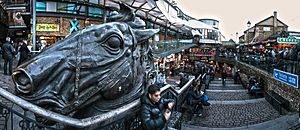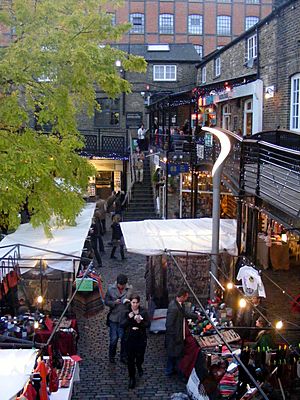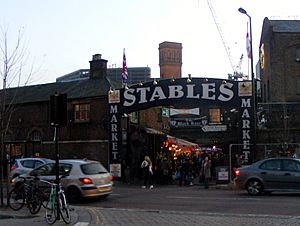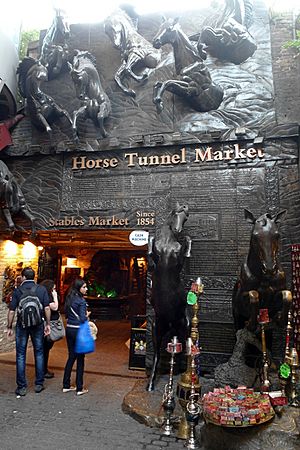Camden Market facts for kids
The Camden markets are a group of large, connected markets in Camden Town, London. People often call them Camden Market or Camden Lock. They are located in old buildings that used to be stables for horses, right next to the Regent's Canal. The markets are famous for being a lively and diverse place. You can find all sorts of things there, like handmade crafts, clothes, unique items, and lots of different kinds of fast food. It's one of London's most popular places to visit, with about 250,000 people coming each week!
A small food market has been in Inverness Street in Camden Town since the early 1900s. But the big Camden markets we know today started on March 30, 1974. It began as a small craft market that was open only on Sundays near Camden Lock. Over time, it grew into a huge area with both temporary stalls and permanent shops. The old Inverness Street market changed too, and now it mostly sells fast food and other items, not fresh produce.
The markets used to be open only on Sundays, which is still the busiest day. Later, most parts of the market also started opening on Saturdays. Some shops that are in permanent buildings are open all week, but the weekends are definitely the most popular times to visit.
In 2014, a billionaire named Teddy Sagi began buying properties in the Camden Market area. By 2015, he owned four of the six main market sections. He announced plans to invest a lot of money to improve the market area.
Contents
The Markets
There are six different markets that make up the Camden markets.
Camden Lock Market
Camden Lock Market is right by the Regent's Canal. This area used to have warehouses and other buildings connected to the canal. In 1974, a temporary market was set up here. By 1976, it had become a well-known part of Camden Town. Originally, Camden Lock was mainly a market for crafts, with stalls outdoors by the canal and inside existing buildings.
Today, you can find many more things, like books, new and used clothes, and jewelry. But it's still the main place in Camden for crafts. There are also many fast food stalls where you can grab a bite to eat. In 1991, a new three-story indoor market hall opened. It was designed to look like the old industrial buildings in the area, using brick and cast iron. Many people came because the stalls were open on Sundays, which was unusual before 1994. In 1993, an incident occurred near the market.
From 2006, a large indoor market hall was built in an area that used to have outdoor stalls. In 2007, a big part of the Stables Market was rebuilt to become a permanent market area that is open all year.
In 2016, a company called Urban Markets acquired Camden Lock. They plan to make it even better, adding more indoor space and increasing the trading area. They want to make it a top arts and crafts center in London.
2017 fire
Early on July 10, 2017, a large fire broke out at the Camden Lock Market. Firefighters quickly arrived to put out the blaze.
Stables Market
The Stables Market is located in old buildings that were once stables and a hospital for horses. These horses used to pull distribution vans and barges along the canal for a company called Pickfords. Many of the shops and stalls are set inside large arches under railway bridges.
You won't find big chain stores here. Instead, there are many small shops and stalls, some permanent and some rented by the day. Like other Camden markets, the Stables Market has lots of clothes stalls. It's also a great place to find furniture. You can discover unique household items, decorative pieces, and interesting second-hand items or antiques from the 20th century. Many of these are handmade. You can also find clothing and art for alternative styles, like goth or cyber-style fashion.
In 2004, the famous radio DJ and TV presenter Chris Evans sold many of his own belongings, from sofas to TVs, at a stall in the Stables Market.
In October 2006, a large indoor market hall was built between the Stables Market and Camden Lock Market. In 2007, the back of the Stables Market was redeveloped. This included new buildings with shops, food places, offices, and workshops. New walkways were added to make it easier for visitors to explore the market. A glass roof and bike parking spaces were also added.
On May 19, 2014, a fire started at the Camden Stables Market. Firefighters quickly handled the blaze, and no injuries were reported.
Camden Lock Village
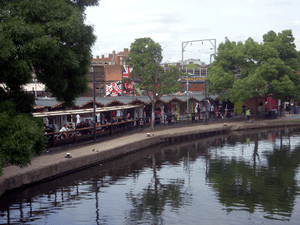
Camden Lock Village was the section of the market along the canal to the east of Chalk Farm Road. It was known as the Canal Market. On February 9, 2008, a fire badly damaged this market. It reopened in May 2009 as the Camden Lock Village.
This market closed in early 2015 because the area is being redeveloped into a new project called Hawley Wharf.
Buck Street Market: 'The Camden Market' (closed down)
The Buck Street Market was an outdoor market that mainly sold clothes. Its sign even said 'The Camden Market'. Some stallholders designed their own clothes. This market is now closed down because the tube station nearby is being renovated.
Electric Ballroom
The Electric Ballroom on Camden High Street has been a night club since the 1950s. It also used to host a weekend market for many years. However, this market closed suddenly in 2015.
Inverness Street Market
A small market has been in Inverness Street near Camden Town Tube station since the late 1800s. It started to lose stalls when local supermarkets opened. By 2013, all the original stalls had been replaced by stalls similar to those in the other Camden markets, selling fast food and other items instead of fresh produce.
See also
 In Spanish: Camden Market para niños
In Spanish: Camden Market para niños


